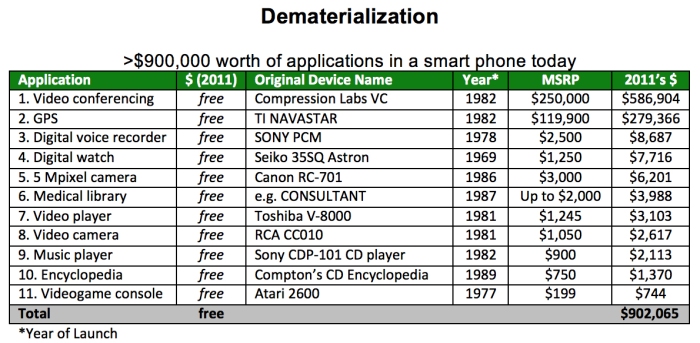In a recent post titled Demonetized Cost of Living, Peter Diamandis describes how technological socialism (i.e. having our lives taken care of by technology) will drive our cost of living close to zero. A similar case was made by Economist Jeremy Rifkin in his book titled The Zero Marginal Cost Society. Diamandis defines demonetization as the ability of technology to take a product or service that was previously expensive and making it substantially cheaper, or potentially free; removing money from the equation. Demonetized is one of the Six D’s of digital, as described by Diamandis and captured in one of my visuals below.

Mr. Diamandis makes a very interesting point in the introduction of his recent post. He rightfully points to the growing concern that exponential technology will impact jobs and earning capacity. He references the pilots underway in places like Canada and Finland that test the idea of a universal basic income - the unconditional provision of a regular sum of money from the government to support livelihood independent of employment. What he says next is what I find interesting:
“But what people aren’t talking about and what’s getting my attention, is a forthcoming rapid demonetization of the cost of living”.
These divergent paths underscore the difficulty in predicting the future. Is it technological unemployment with social unrest, or a world of abundance with significant cost of living reductions? It highlights one of my favorite and often used quotes from Fast Future Research: “The challenge is to rehearse the future and prepare for a range of possibilities”.
Mr. Diamandis goes on to describe the categories of consumer spend in three large economies: The United States, China, and India. Some statistics from the post:
- In the U.S., in 2011, 75% of Americans’ expenditures come from Housing, Transportation, Food, Personal Insurance, and Health
- In China, per a recent Goldman Sachs Investment Research report, there is a similar breakdown — Food, Home, Mobility, and Well-Being make up the majority of the expenditures
- In India, with a population of 1.2 billion people, expenditures on Food, Transportation, and Miscellaneous Goods and Services are most prominent
Overall, the majority of expenditures are in 7 categories: transportation, food, healthcare, housing, energy, education, and entertainment. The remainder of the post focuses on the demonetization argument. In his book titled Abundance he provides a chart that shows the demonetization of $900,000 worth of products and services – all of which are now available via your Smartphone:

He then describes how each of the top seven expenditure categories will demonetize.
Transportation:
As a Mobility Ecosystem emerges, the automotive market is increasingly demonetized. Whether it’s by startups like Uber or the driverless transportation networks that emerge, the cost of transportation will drop. In his post, Diamandis references costs that will likely disappear: auto insurance, auto repairs, parking, fuel, parking tickets, etc. The economics will ultimately favor access over ownership.
Food
As he notes in his book, the cost of food has dropped thirteen fold over the past century. The expectation is that the reduction will continue. Additional gains will be made in the efficiency of food production through local vertical farming (70% of food’s final retail price comes from transportation, storage and handling), and genetic and biological advances that increase yield per square meter.
Healthcare
Advances across four major categories will drive the demonetization of healthcare:
| Diagnostics | AI-based diagnostics |
| Surgery | Robotic surgery |
| Eldercare | Robotic elder care |
| Medicine | AI discovered and manufactured, while compounded at home via 3D printing |
Housing
Diamandis sees the demonetization of housing via key technology drivers that 1) make the proximity of your home to your job irrelevant, and 2) drive down the cost of building structures. Autonomous cars will make our commute productive, thereby eliminating the need to live in expensive city centers close to our jobs. Virtual reality provides a virtual office where your coworkers are avatars, thereby eliminating the need to commute at all. From a cost standpoint, Robotics and 3D Printing will demonetize the cost of building structures.
Energy
Fun fact: Five thousand times more energy hits the surface of the Earth from the Sun in an hour than all of humanity uses in a year. The cost of Solar will continue to demonetize through further material science advances that increase efficiencies.
Education
As Diamandis notes, education has already been demonetized in many respects, as most of the information you’d learn in school is available online, for free. Soon the best professors in the world will be an Artificial Intelligence that knows the exact abilities, needs, desires, and knowledge of a student and personalizes their education.
Entertainment
The advent of music streaming services, YouTube, Netflix and the iPhone App Store have delivered an explosion of available selections, while entertainment that historically required significant purchases of equipment and services rapidly demonetizes.

I have a different take on the Fast Future Research quote. I think the challenge is to rehearse the range of possibilities to prepare for the future.
LikeLiked by 1 person
You can’t see the possibilities unless you have some view of where the future is going
LikeLiked by 1 person
I get your point but what comes first: the possibilities or the future?
LikeLike
The future introduces a range of possibilities. The struggle lies more with understanding where humanity is going. If autonomous vehicles take 15 years to play out – one set of possibilities exist. If it accelerates to 5 years – a different set of possibilities exist
LikeLiked by 1 person
[…] After AI takes all of the jobs and UBI comes to the fore… will it later become a case of the decline in the relevance of money itself? https://frankdiana.net/2016/07/20/technological-socialism-and-demonetization/ […]
LikeLike
[…] this scarcity and inefficiency, the drive towards productivity creates abundance – the same Abundance described by Peter Diamandis in a book of a similar title. Jeff connects the dots, showing how the […]
LikeLike